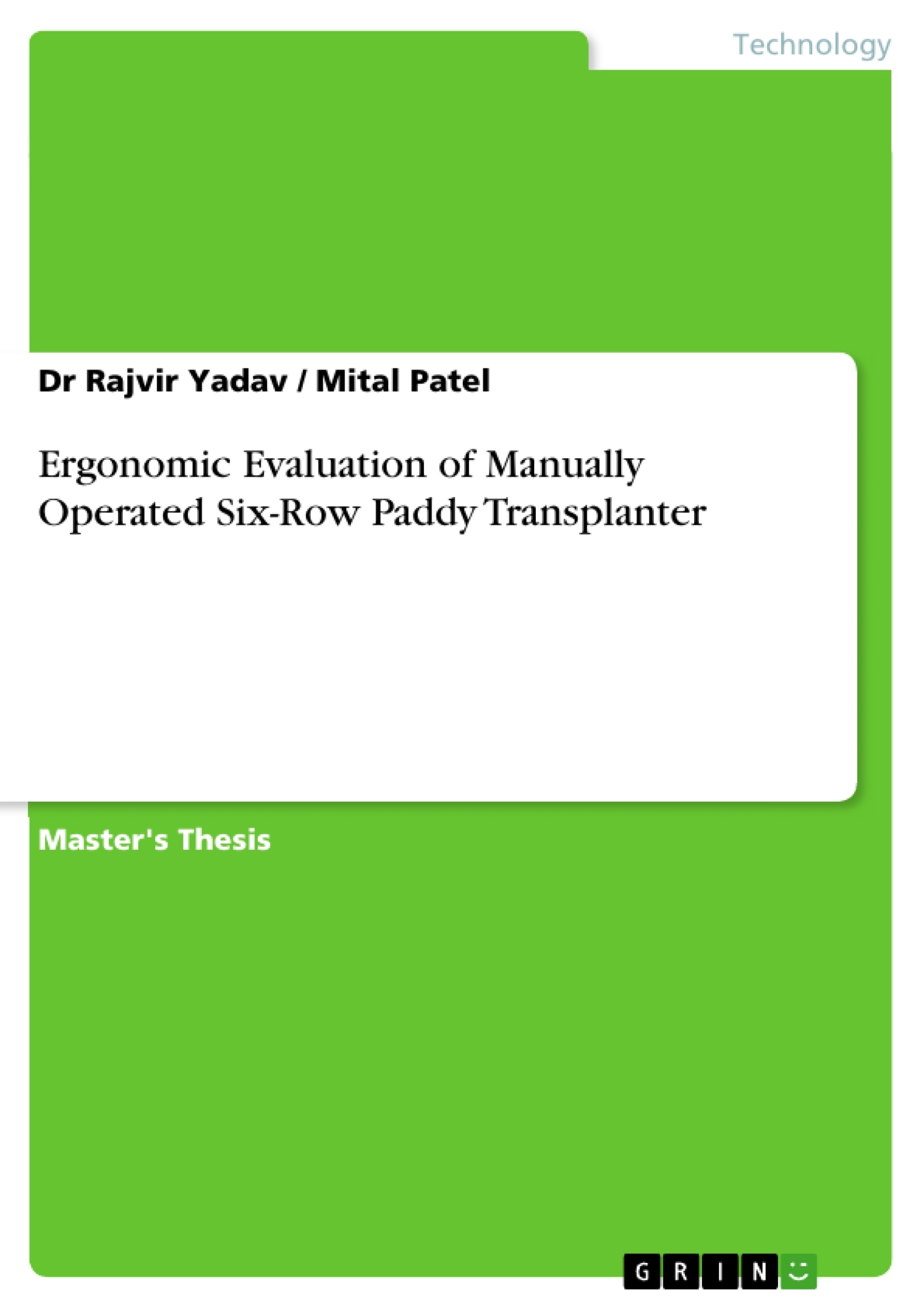Ergonomic evaluation of manually operated six-row paddy transplanter was carried out. Human energy is predominantly used in most of the rice farming operations starting from seedbed preparation to threshing. High labour demand during the peak periods adversely affects the timeliness of operation, thereby reducing the crop yield. To offset these problems, mechanical transplanting is the solution. For that farm implements and machinery have been ergonomically designed which minimize drudgery of the labour and increase productivity at reduced expenditure levels which can provide a rational basis for recommendation of methods and improvement in equipment design for more output and operator’s comfort and safety. Three male and female subjects were selected randomly. The parameters used for the study include heart rate and force measurement to get energy cost and rest pause.
The physiological cost was worked out during transplanting operation by manually operated six-row paddy transplanter for male and female subjects, which was found to be 30.70 and 32.58 kJ min-1 respectively. On the basis of the heart rate, the operation by manually operated transplanter was graded as ‘heavy’. Similarly transplanting by hand, the physiological cost was found to be 22.46 and 20.45 kJ min-1 for male and female subjects respectively and accordingly graded as ‘moderately heavy’.
The rest pause for achieving functional effectiveness of the paddy transplanter is 30 minutes of work followed by 14.30 min rest. More force in pulling the transplanter in forward direction by male and female subjects was obtained which was 130.32 and 145.12 N respectively as compare to force required in handle up and handle down position of the transplanter which were 101.93 and 94.61 N for male subject while for female subject, it was 117.08 and 109.34 N respectively. More force is required for female workers as compared to male workers because of males are stronger in pulling the transplanter.
Inhaltsverzeichnis (Table of Contents)
- ABSTRACT
- ACKNOWLEDGEMENT
- CONTENTS
- LIST OF TABLES
- LIST OF FIGURES
- NOMENCLATURE
- INTRODUCTION
- REVIEW OF LITERATURE
- Physiological Evaluation
- Rest Pause
- Energy Requirement
- Force Measurement
- MATERIALS AND METHODS
- Selection of Subjects for the Transplanting Operation
- Growing of Seedlings
- Preparation of the Field for Transplanting
- Transplanting of Seedlings
- Manually Operated Six-row Paddy Transplanter
- Ergonomic Evaluation
- Heart rate measurement
- Energy cost of operation
- Rest during work
- Force measurement in paddy transplanting operation
- RESULTS AND DISCUSSION
- Selection of Subjects
- Physiological Aspects of the Subjects
- Heart rate variation
- Energy expenditure rate
- Rest pause
- Transplanting force
- SUMMARY AND CONCLUSIONS
- BIBLIOGRAPHY
- Appendix
Zielsetzung und Themenschwerpunkte (Objectives and Key Themes)
This research aims to evaluate the ergonomic performance of a manually operated six-row paddy transplanter. The study focuses on reducing labor demands and increasing productivity in rice farming, specifically during transplanting. It analyzes the physiological cost and energy expenditure of using this transplanter compared to manual transplanting, ultimately seeking to improve equipment design and operator comfort and safety.
- Ergonomic evaluation of a manually operated paddy transplanter
- Physiological cost and energy expenditure during transplanting
- Impact of the transplanter on operator comfort and safety
- Comparison of manual and mechanical transplanting methods
- Recommendations for equipment design improvement
Zusammenfassung der Kapitel (Chapter Summaries)
- Introduction: This chapter provides an overview of the research and its significance, highlighting the challenges associated with labor-intensive rice farming operations and the potential benefits of mechanical transplanting.
- Review of Literature: This chapter examines existing literature on physiological evaluation, rest pause, energy requirements, and force measurement in relation to agricultural operations, providing a theoretical framework for the study.
- Materials and Methods: This chapter describes the methods employed in the study, including the selection of subjects, growing of seedlings, field preparation, transplanting techniques, the design of the six-row paddy transplanter, and the specific ergonomic evaluation methods used.
- Results and Discussion: This chapter presents the findings of the study, analyzing the physiological cost of using the transplanter compared to manual transplanting, examining heart rate variation and energy expenditure, determining the optimal work-rest cycle, and investigating the force required for operating the transplanter.
Schlüsselwörter (Keywords)
The primary focus of this study is on the ergonomic evaluation of a six-row paddy transplanter. Key concepts include physiological cost, heart rate, rest pause, transplanting force, and the comparison of manual and mechanical transplanting methods. The research seeks to improve the efficiency and comfort of rice farming operations, reducing labor demands and enhancing productivity.
- Citar trabajo
- Ph D Dr Rajvir Yadav (Autor), Mital Patel (Autor), 2005, Ergonomic Evaluation of Manually Operated Six-Row Paddy Transplanter, Múnich, GRIN Verlag, https://www.grin.com/document/437934



